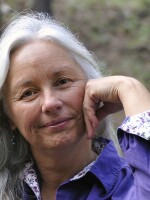
Rose Houk
Earth Notes writerRose Houk is a Flagstaff-based writer and editor, specializing in natural history and environmental topics. Rose was a founding contributor of KNAU's Earth Notes and has written nearly 200 scripts for the series. She is also the author of many publications about national park and monuments, along with audio productions.
-
On a walk through the woods, you might see a strange-looking growth up in the branches of a tree. It’s called a witches’ broom.
-
Biochar, made from burned plant material, is giving new life to waste — and helping fight climate change in the process.
-
The American pika is a small mammal that inhabits the highest elevations in the western mountains. Members of the rabbit family, pikas are approximately 7 inches long, characterized by outsized ears, short legs and a chunky, furry body.
-
Loggers worked nonstop during the Great Depression. One of the longest-standing logging communities was a place called Apex along the Grand Canyon Railway, north of Williams and near the Canyon’s South Rim.
-
The vast Great Basin stretches west from the Colorado Plateau across much of Utah and Nevada. The region is so named because bodies of water drain inland with no outlet to the sea.
-
The Species from Feces Lab at Northern Arizona University examines DNA in animal feces. The lab’s motto is "to be number one at number two.”
-
Though distinct disciplines, both paleontology and archaeology use similar technologies and methods in their work and show fascinating intersections.
-
High-tech may be coming to the Southwest’s rangelands with an idea called virtual fencing.
-
For the first time in the United States, biologists have used a flu vaccine designed specially to protect the endangered California condor.
-
Renewable energy eases the world’s reliance on fossil fuels and cuts CO2 emissions. But the benefits of these advances also come with costs.











